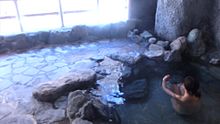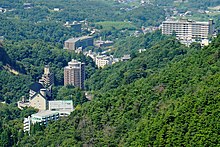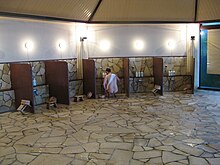Onsen
An onsen ( Japanese 温泉 , often shown on maps and signs as 湯 or ゆ ( yu , hot water)) is the Japanese name for a hot spring . In general, an onsen is a thermal bath or a place with hotels that have a bath fed by natural hot springs - nowadays mostly separate for men and women. In a broader sense, this also includes places whose spring water has to be heated.
Characteristics

Since all of Japan is in volcanically active area, onsen can be found almost everywhere in Japan. The southernmost are found in Taiwan , where they were established during the Japanese colonial era. Cities in Japan with many good onsen are health resorts ( 保養 h , hoyōchi ) based on the western model and they can be recognized by the fact that their name is appended with an "onsen". The three most famous onsen are the Kusatsu- Onsen in Gunma , the Arima Onsen in Kobe and Gero- Onsen in Gifu . Other famous health resorts are the Beppu- Onsen on Kyūshū and the Dōgo-Onsen in Matsuyama on Shikoku .
Traditionally, onsen have their pools outdoors, but today's onsen mostly have both indoor and outdoor pools. Unlike the Sento, the water has to come from a volcanic spring, but it can be artificially heated. Many onsen also have other spa facilities, artificial waterfalls, massage services, and saunas. Nevertheless, some of the most famous onsen, such as the Tsuru-no-Yu-Onsen ( 鶴 の 湯 温泉 ) in Semboku , Akita Prefecture , have retained their originality and forego such additional offers. Due to the high mineral content in the water of many onsen, they are considered health-promoting; But it can also be that minerals are added to the different pools of an onsen.
The bathroom, and thus the onsen, play an important role in Japanese culture, primarily for relaxing after work. As with the Sento, you wash yourself thoroughly before immersing yourself in an onsen basin. Traditionally, the whole village bathed naked in the onsen without separation of the sexes, which changed with the "westernization" in the course of the Meiji restoration . There are still a few onsen in which men and women bathe unclothed together. Open to the public and newer mixed onsen require swimwear, but normal onsen does not want this.
Sources from which water gushes so hot that you can no longer bathe in it are also known as jigoku (hell).
Onsen etiquette
Tattoos are actually forbidden in many onsen, just like in Sentō . This primarily affects members of organized crime ( yakuza ), as tattoos used to be strongly associated with this milieu in Japan.
In general, onsen in Japan are a place of relaxation, where the strict code of conduct that regulates social life is relaxed and the hierarchies are leveled. In the onsen, the little employee sweats on an equal footing with the company boss. However, it is rare for company groups to visit an onsen; friends, families and couples visit an onsen together. Much emphasis is placed on quiet, but there can be a quiet conversation. It can also happen that strangers start a conversation with one another, which is rarely the case in other life.
There is a changing area in front of the bathroom where clothes can be placed in a basket or locker. The onsen equipment includes a small towel ( tenugui ) that you can put on your forehead to wipe off your sweat, you can also hold it discreetly in front of your genital area while walking or use it to cover a tattoo. Before getting into the water, take one of the small benches and a bowl and go to one of the numerous washing areas with cold and warm water on one wall of the bathroom: you can shower while sitting on the bench or you can wash yourself over with water from the bathroom Bowl. Many bathers take full body care, including a shave.
Some onsen (for example the dogo-onsen ) offer a space for relaxation after the bath, in which you can sit in the yukata on a zabuton and enjoy a bowl of tea.
Faux pas when using it
The following are considered faux pas when using an onsen:
- Taking off your shoes too late and staining the area. The undressing usually takes place in front of a wooden step.
- Getting up from the bench when showering.
- Not washing yourself thoroughly with soap and shampoo before taking a bath and thus polluting the onsen water.
- Not rinsing off the foam thoroughly and polluting the onsen water.
- Bringing a used washcloth into contact with the onsen water and thus polluting the onsen water.
- Not to dry off when going out to the changing area.
There are exceptions, however. People who have just showered often just pour warm water over themselves. Especially the genital area and the feet are doused with water. This is a symbolic cleaning of the areas that are perceived as "dirty". If the washcloth is therefore still dry, it will be wetted in the onsen water.
Despite these exceptions, the basic rules are traditionally strictly adhered to. People should also be clean. The toilet area is perceived as dirty and therefore other loafers are put on there in order not to dirty the bathing area, among other things. Many rules of conduct can be explained with a need for cleanliness.
Medicinal effects
Much like a visit to a sauna , a hammam , a Banja , a steam bath or hot spring , the stay at an onsen has a positive effect on subjective well-being. The blood circulation in the skin is stimulated and skin aging is delayed. Muscle tension is released.
People with inflammation , with acute infectious diseases , with cardiovascular diseases , with venous thrombosis or varicose veins should never visit an onsen, sauna, banya, hammam, steam bath or thermal bath .
Others
- The map symbol for onsen is also part of the Unicode . It is located in the “ Various symbols ” block as the character U + 2668 (9832).
- Onsen tamago or onsen eggs are eggs that have been cooked in an onsen.
literature
- Anne Dobberkau: Thermal Spa Tourism in Japan: Case Study Nyûtô Onsen . Akademische Verlagsgemeinschaft München AVM, Munich 2010, ISBN 978-3-89975-401-8 / ISBN 978-3-86924-676-5 ( Master's thesis , Humboldt-Universität zu Berlin 2010, 137 pages).
- Marie-Luise Legeland: Onsen: thermal springs as a travel destination. Spa treatments and tourism in Japan . DIJ German Institute for Japanese Studies . Iudicium Verlag, Munich 2013, ISBN 978-3-86205-041-3 .
Web links
- Onsen on the Sakura Heaven page (private website)






